Would you like the recipe for writing killer SEO content that ranks and converts?
SEO content is an essential ingredient to a successful website as it helps boost your online visibility, drive traffic, and grow your business. However, creating content that does all of these is a science that many don’t take the time to master.
In this article, we’ll show you everything you should know about SEO content. We’ll also include some content optimization tips and tools.
In This Article
- What is SEO Content?
- Why is SEO Content Important?
- How to Develop an SEO Content Strategy
- How to Write and Optimize SEO Content: 7 Tips
- Monitoring the Performance of Your SEO Content
- 2 SEO Content Case Studies to Learn From: Plus Takeaways
- SEO Content: Your FAQs Answered
- SEO Content: The Key to Organic Traffic
What is SEO Content?
SEO content is online content designed to rank high in organic search results. But to understand it properly, we need to break down the term:
- SEO: Search engine optimization (SEO) is the practice of improving your site and its content to increase visibility on search engines when people search for keywords and topics related to your business.
- Content: Refers to any information created to live and be consumed on the internet.
This means SEO content is any information designed and created to live and be consumed on the internet and must be easily discoverable by searchers.
Types of SEO Content
Now that you know what SEO content is, let’s quickly look at some common types of SEO content.
Blog Posts and Articles
These comprehensive content pieces are the backbone of many successful SEO strategies. They are designed to be educational, informative, and authoritative. They can also have conversion-based elements to encourage readers to take a particular action.
Product Pages
Product pages are pages on your website that showcase your products. They help your customers decide what they want to buy on your site. They have valuable information such as specifications, prices, features, reviews, product comparisons, etc.
Guides and Tutorials
These are designed to help a reader solve a problem, ideally with your product or service. They are a great way to get your target audience to trust you and your product. Plus, creating this kind of content is a great way to become the go-to resource in your industry, resulting in more organic traffic and inbound leads.
Infographics and Multimedia Content
Visual elements are great tools to enhance engagement. But they can also help your SEO efforts as they give you an opportunity to rank for video and image searches. Check out our guide on image SEO for details on enhancing the visibility of your visual elements in search.
Why is SEO Content Important?
SEO content goes beyond just climbing the ranks on Google. After all, your blog or business doesn’t grow from rankings alone.
So, why is SEO content important?
Let’s quickly look at why you should invest in SEO content.
High Rankings, More Traffic
SEO content is optimized for specific keywords and phrases relevant to your business or niche. When people search for these terms, your content has a higher chance of appearing on the search engine results pages (SERPs).
Ranking high on SERPs results in higher visibility, which, in turn, translates to increased organic traffic to your website.
Build Credibility and Authority
Remember, SEO content is designed to rank high on SERPs. If you have a lot of high-ranking content, searchers will see your brand appearing often for terms they input into search engines. As a result, you’ll be seen as an authority in your niche.
Boost your Bottom Line
Well-crafted SEO content helps you demonstrate expertise in your field and establishes your website as a credible source of information. This results in readers trusting your brand, resulting in higher conversion rates. It also plays a big role in increasing customer loyalty and retention. All these are elements that can help boost your bottom line.
How to Develop an SEO Content Strategy
For your SEO content to be effective, you need to develop a strategy for creating and promoting it. You can’t create impactful content randomly. You have to deliberately design an effective SEO content strategy. It’s essential for improving your online visibility and attracting organic traffic. Here’s a step-by-step guide to help you craft a successful SEO content strategy:
Use the Right WordPress SEO Tool
One of the first steps to developing an effective SEO content strategy is investing in the right SEO tool. And for WordPress users, there’s no better tool than All In One SEO (AIOSEO).

AIOSEO is a powerful yet easy-to-use SEO plugin that boasts over 3 million active installs. Millions of smart marketers and bloggers use AIOSEO to help them boost their search engine rankings and drive qualified traffic to their blogs. That’s because the plugin has many powerful features and modules designed to help you properly configure your SEO settings. Examples include:
- Cornerstone Content: Easily build topic clusters and enhance your topical authority and semantic SEO strategy.
- Author SEO: Easily demonstrate Google’s E-E-A-T in WordPress.
- Search Statistics: This powerful Google Search Console integration lets you track your keyword rankings and see important SEO metrics with 1-click, and more.
- SEO Revisions: Track any changes you make to your site and see their impact on your SEO. Plus, you get to see on a timeline how Google updates affect your site.
- Advanced Robots.txt Generator: Easily generate and customize your robots.txt file for better crawling and indexing.
- TruSEO Highlighter: Makes it easy to spot on-page SEO issues and gives recommendations for fixing them.
- Next-gen Schema generator: This no-code schema generator enables users to generate and output any schema markup on your site.
- Link Assistant: Powerful internal linking tool that automates building links between pages on your site. It also gives you an audit of outbound links.
- SEO Preview: This gives you an overview of your search and social snippets and general SEO so you can improve your optimization.
- IndexNow: For fast indexing on search engines that support the IndexNow protocol (like Bing and Yandex).
- Sitemap generator: Automatically generate different types of sitemaps to notify all search engines of any updates on your site.
- And more.
AIOSEO also has many other features to help you boost your local SEO, on-page SEO, and technical SEO. It also has a dedicated WooCommerce SEO module for those with eCommerce stores.
For step-by-step instructions on how to install AIOSEO, check our detailed installation guide.
Research Intent-focused Keywords
Keyword research is a foundational aspect of creating SEO content. That’s because every online search starts with a keyword.
Keyword research involves understanding the words, phrases, and questions your target audience uses when searching for information relevant to your business or product. It also involves strategic tasks like checking keyword difficulty and whether targeting those keywords is feasible.
To make your keyword research easy, use a keyword research tool. Examples include Semrush, Ahrefs, Google Keyword Planner, and more. Also, focus on long-tail keywords to capture more specific search queries. Plus, they have low competition, giving you better chances of ranking.
Besides keyword discovery, you also need to understand search intent. This is the reason behind the search query. While it may sound complicated, figuring out search intent is quite easy. Two of the best ways to do it are:
- Using tools: keyword research tools like Semrush have a search intent feature that helps highlight the most common user intent behind a keyword.
- Studying SERPs: Study the SERPs and see the type of content that ranks well.
Understanding search intent is important as it helps you create SEO content that satisfies your target audience’s search queries. As a result, it will convert better.
Understand Your Target Audience
Many marketers and SEOs make the mistake of optimizing content for search engines. That’s not what SEO content is about. Genuine SEO content also considers the target audience.
That’s why you must include audience research when developing your SEO content strategy. This includes thinking about:
- Who is your intended audience?
- What problems are they likely to have?
- What solutions are they looking for?
- Do they have a particular way of speaking (lingo)?
Answering these questions will give you the foundation you need to conduct impactful keyword research. It also helps you create personalized content, making your audience trust you more. It also helps boost your conversion rates and increases the chances of it being shared.
By tailoring your content to address the needs and interests of your audience, you ensure that it ranks well and satisfies your audience.
Create a Content Calendar
A content calendar, or an editorial calendar, is a planning tool used to organize and schedule content creation over a specific period. It makes managing your content marketing tasks easier, from ideation to promotion.
Creating a content calendar is essential as it will help you publish SEO content consistently. As a result, you’ll always have fresh content. This is important to SEO because:
- Search engines favor fresh content over old content
- You can create content to target different keywords
- More content results in greater search visibility
You should also consider including content refreshes in your content calendar as they help you combat content decay.
Prioritize High-Quality Content
An essential aspect of an impactful SEO content strategy is creating high-quality content. This means creating valuable, informative, and engaging content that addresses the needs of your audience.
Aim for longer-form content when appropriate, as it tends to perform better in search rankings. This is because it comprehensively covers a topic. You should also leverage content optimization tools to ensure your content is primed for rankings.
Be Strategic About Distribution
Content distribution refers to the strategic promotion and sharing of content across various online channels to maximize its reach, visibility, and impact. Content distribution aims to ensure that your content reaches the right audience in the right places at the right time. This helps foster engagement, brand awareness, and, ultimately, achieving your marketing objectives.
For your content distribution to be effective, focus on the channels and platforms your target audience spends the most time on.
How to Write and Optimize SEO Content: 7 Tips
Now that you know what SEO content is and why it’s important, let’s dive into some best practices for creating it.
1. Nail Your Research
The first step to writing SEO content is researching your content thoroughly. We’ve already looked at keyword and audience research, so we’ll take the research aspect a bit further here and look at competitor research.
Competitor research, also known as competitor analysis, refers to the process of evaluating your primary competitors to see what’s working for them. This includes:
- Identifying your primary competitors
- Keywords they’re ranking for
- The type of content performing well for them
- Keyword and content gaps
- Their internal and backlinking strategy
You can use AIOSEO’s SEO Analysis to analyze your competitor’s SEO and some of their gaps.
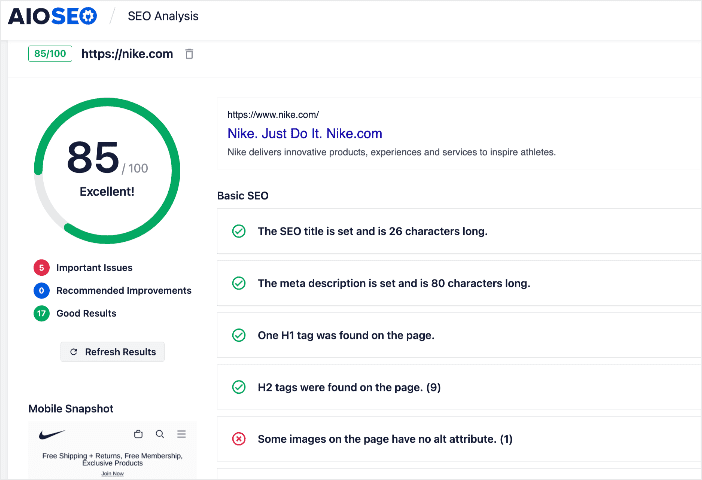
You can use this data to improve your site and content.
2. Focus on Quality and E-E-A-T
For your SEO content to stand a chance of ranking, it must be of high quality. This means it must be:
- Well-written
- Informative
- Structured well
- Relevant
- Accurate and credible
You should also ensure that your SEO content meets Google’s E-E-A-T content standards. It should be expertly written, feature personal experiences, be authoritative, and be trustworthy. One way of achieving this is by enlisting the help of subject matter experts when creating content around complex topics.
Check out our tutorial on implementing E-E-A-T right inside WordPress.
3. Keyword-optimize Your Content
While you could get away with keyword stuffing in the past, that isn’t the case anymore. Instead, you should use your keywords strategically in your content. This means using your target keyword in your:
- Headline
- Introduction and conclusion
- Headers
- Meta description and SEO title
- In your content
Besides using your target keyword, consider including synonyms and LSI keywords. This helps search engines understand your topic and that you’re covering it thoroughly.
4. Craft Compelling Headlines
Your headlines play a huge role in how search engines rank your content. They’re an essential part of on-page SEO. They also help users determine whether your content will satisfy their search query or not.
That’s why you should invest time in crafting compelling SEO-friendly headlines.
To do this:
- Include your keyword, preferably as close to the beginning as possible
- Craft a headline that meets search intent
- Use action words to spur readers into action
- Keep it simple and avoid being clever, using jargon, etc.
Your headline helps set expectations for the rest of your content. Getting it right encourages users to read the rest of your content.
Here are a few more tips for optimizing your headlines.
5. Optimize Your Search Snippets
A search snippet is the short blurb of your content on search engines and includes the:
- URL
- Meta description
- SEO title
Sometimes, it can include special features like jump links.
Here’s an example of a search snippet:
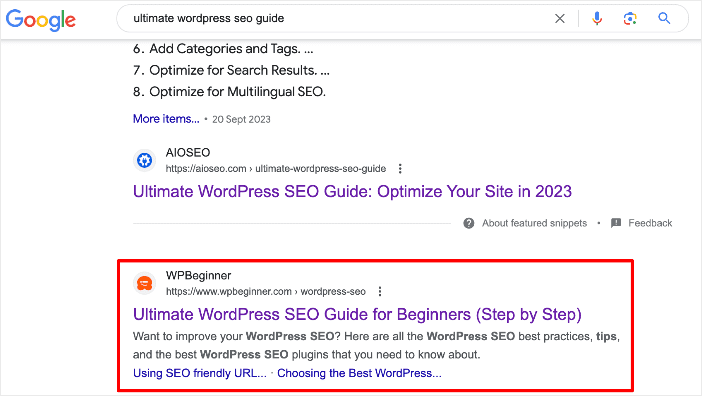
Optimizing your search preview is easier using AIOSEO’s SEO Preview tool. This shows you what your search snippet will look like on SERPs.

It also shows you how your snippets will look when shared on Facebook and X. Using a SERP preview tool as part of your SERP analysis helps you boost your conversion rates.
6. Optimize Your Headers
Header tags, also known as HTML header tags or HTML heading tags, are HTML elements used to markup and separate headings and subheadings in your content.
Besides breaking up content into subsections, header tags also:
- Tell web browsers how to display content
- Help search engines understand your page and content better
Header tags rank in order of importance, starting from H1 (which is usually the title tag or most important heading) to H6 tags.
When crafting SEO content, some tips for optimizing your header tags are:
- Include your target keyword
- Reinforce search intent
- Be descriptive
For a detailed look, check out our guide on header tags and how to use them to boost your SEO.
7. Add Internal Links
Internal linking means adding links to and from the pages on your site. We call these links “internal” because they’re within your website.
Internal linking is a powerful SEO practice as it helps:
- Keep readers on your site for longer
- Distribute “link juice” across your site
- Search engines better understand what your site is about
- Improve crawling and indexing
- Improve site navigation
But as your website grows, remembering all the articles you can link to becomes next to impossible. Manually adding internal links becomes impossible. That’s why you should consider a tool like AIOSEO’s Link Assistant.

Link Assistant helps you build strategic internal links on autopilot, making the task much easier. It also shows the orphaned pages on your site, which are pages without any internal links, a problem that can hurt your SEO and user experience (UX).
To make internal linking easy and fast, Link Assistant will suggest which articles to link to in your content and the anchor text to use. You can include all link suggestions at once or add them individually as you vet them.
Click here to learn more about how to improve internal link building on your site. This is one of the many WordPress SEO tips that should be non-negotiable.
Monitoring the Performance of Your SEO Content
Monitoring the performance of your SEO content is a crucial aspect of running an impactful SEO campaign. If you’re a WordPress user, this can be easily done using AIOSEO’s Search Statistics module.
Search Statistics is a powerful Google Search Console integration that lets you track your keyword rankings and see important SEO metrics with 1-click. It comes with many reports for monitoring SEO performance.
There are 3 ways you can use Search Statistics to monitor SEO performance:
1. Monitoring Your Overall SEO Metrics
Checking the performance of your SEO content in WordPress is super easy. To do so, head over to Search Statistics in the AIOSEO menu. Clicking on this leads you to the Search Statistics Dashboard.
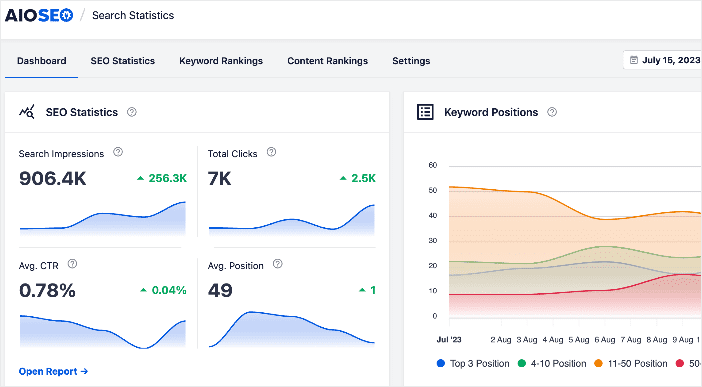
The Dashboard section will give you an overview of important SEO metrics like Search Impressions, Total Clicks, Average CTR, and Average Position. It also shows you an overview of the number of keywords ranking at different positions. You can see this in the Keyword Positions section.
The Keyword Positions graph gives you an overview of how your content is performing.
Besides the overview on the dashboard, there are two other reports that can help you check your search visibility. These are the Keyword Ranking report and the Content Performance report.
2. Using the Content Performance Report
AIOSEO’s Search Statistics module comes with a Content Performance report that shows how your posts and pages are performing on SERPs. To access it, go to AIOSEO » Search Statistics » SEO Statistics. Next, scroll down to the Content Performance report.

The Content Performance report shows you 3 main content metrics, namely:
- Top Pages: This shows you your best-performing pages.
- Top Losing: This shows the pages losing rankings the most.
- Top Winning: This shows the content that’s gaining higher rankings.
The Content Performance report gives you key metrics like Clicks, Impressions, Position, and Diff (change in position) for each page in this report. These give you deep insights into what’s happening to your content on SERPs.
Regarding the performance of your SEO content, the 2 most important metrics are Position and Diff. The positions tab shows you each page’s position on SERPs, while the Diff shows whether your content is improving in performance or decaying.
3. Checking SEO Content Performance Using the Keyword Rankings Report
The Keyword Rankings report gives you great insights into how your content is performing for your target keywords. You can check this report by going to AIOSEO » Search Statistics » Keyword Rankings.
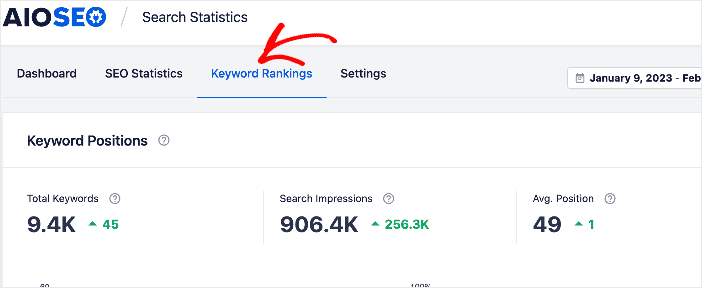
This is where you get a detailed report of all your keywords and their performance on SERPs. The report shows vital information like the Total Keywords you’re ranking for, Search Impressions, and Average Position. These metrics give you a general overview of your rankings and online reach.
To get a more granular view of how you’re performing for specific keywords, scroll down to the Keyword Performance section.

Essential metrics for each keyword include Clicks, Average CTR, Impressions, Position, and Diff.
The tab to keep an eye out for as you monitor the performance of your SEO content is the positions tab. It gives you the SERP position of your keywords, enabling you to see how well you’re ranking for it.
2 SEO Content Case Studies to Learn From: Plus Takeaways
Before we wrap things up, let’s look at some case studies to validate the principles and practices we shared above.
1. Golf Blog Boosts Traffic By Optimizing Content
Golfer Geeks was founded in 2015 by Jamie Boudreaux, an avid golfer and entrepreneur.
He started the website to share his enthusiasm for the sport and connect readers with the right equipment and tips for improving their game.
Nine months into 2023, the site more than doubled its organic traffic compared to the total traffic generated in 2022.
How did they do it?
The team behind the site focused on improving their content and optimizing it for search. Of particular note, some SEO best practices they implemented include:
- Using content structure to improve the user experience
- Fighting content decay with regular updates
- Optimizing images for search engines
- Implementing FAQ schema for People Also Ask results
Check out the full Golfer Geeks case study for more insights on how this blogger skyrocketed his rankings and organic traffic by optimizing their content.
2. AI High School Program Grows Traffic by 427% in 3 Months
Inspirit AI is an online AI training program for high school students. It was developed by alumni and graduate students from Stanford and MIT.
Their mission is to inspire the next generation to use AI as a tool for shaping a brighter future.
Inspirit AI was founded in 2019, although traffic was minimal during its first year. In 2022, the total traffic was 34,165. However, from January 2023 to September 2023, the site had a whopping 293,444 organic visitors.
Some of the key factors that led to the site’s traffic skyrocketing include:
- Increasing content production
- Targeting long-tail keywords
- Optimizing for People Also Ask
In a nutshell, SEO content resulted in some pretty big wins for the brand.
Check out the full story and some practical takeaways from our InspiritAI case study.
SEO Content: Your FAQs Answered
What is SEO content?
SEO content refers to web content created with the goal of optimizing it for search engines. This involves incorporating relevant keywords and other SEO best practices to improve the content’s visibility in search engine results.
Why is SEO content important?
SEO content is crucial for improving online visibility, attracting organic traffic, and establishing online credibility. It also helps enhance user experience. It helps websites rank higher on search engine results pages (SERPs), driving more targeted traffic and potential customers.
How can I monitor the performance of my SEO content?
WordPress users can monitor the performance of their SEO content by using tools like AIOSEO’s Search Statistics. It’s a Google Search Console integration that gives you SEO data right inside your WordPress dashboard.
SEO Content: The Key to Organic Traffic
SEO content is an essential ingredient of any content marketing strategy. It helps boost your search visibility, conversion rates, and revenue.
We hope this post has helped you understand SEO content and its importance. You may also want to check out other articles on our blog, like our beginners’ guide to SEO or our guide to SEO copywriting.
If you found this article helpful, then please subscribe to our YouTube Channel. You’ll find many more helpful tutorials there. You can also follow us on X (Twitter), LinkedIn, or Facebook to stay in the loop.
Disclosure: Our content is reader-supported. This means if you click on some of our links, then we may earn a commission. We only recommend products that we believe will add value to our readers.
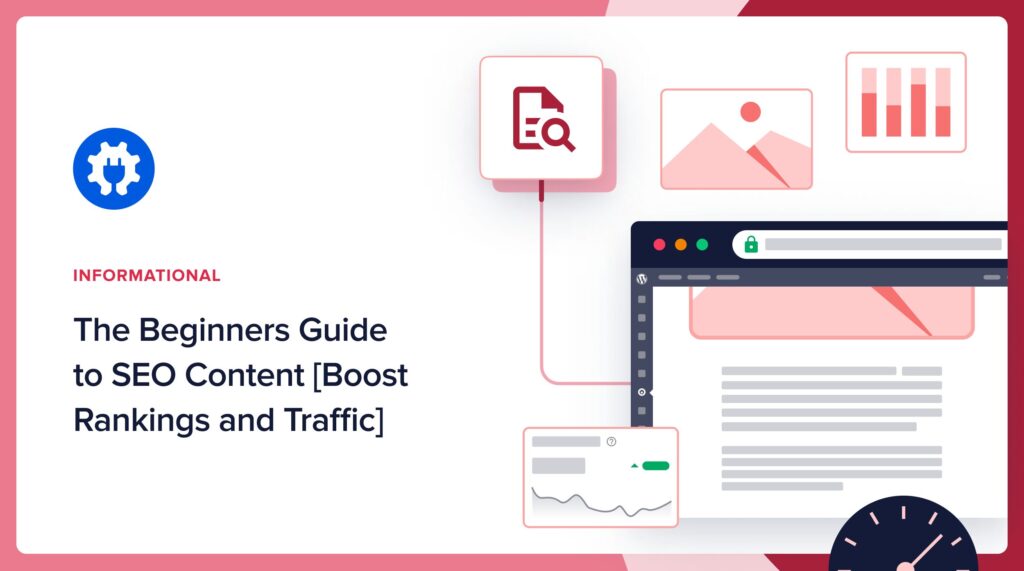

Your blog is a true hidden gem on the internet. Your thoughtful analysis and in-depth commentary set you apart from the crowd. Keep up the excellent work!